Sick Beard – Naming convention for “Specials”
Some shows occasionally air so called specials … but how do I make Sick Beard recognize them?
This is what worked for me:
- Create a sub-folder called “Specials” in the folder of your particular TV-Show and copy the specials you might have in that new folder (where “Season 01”, “Season 02” etc can be found as well).
- Open the show details in Sick Beard and scroll down to the “Specials” section.
Now when you look in the “Episode” column, you will see a number for the articular special you’re looking for.
Remember this number! (“6” in the example below)

Sick Beard – Naming convention of the Specials
- Now go to this file in the Windows Explorer, MacOS Finder, or whatever you use to browse files on your computer.
Here we are going to rename the files that you copied in the “Specials” folder, to match the numbering format:
00xEP – special episode title
where:
00 is to indicate the season “00” a.k.a. “Specials”, and
EP is the episode number we just remembered from the “Episode” column. Add a zero before the number if needed.
Example: Archer (2009) – 00×06 – Heart of Archness – Part III.avi
Repeat these steps for every special you have. Once done with the renaming and moving of files, initiate a “Re-Scan” in Sick Beard. Sick Beard will now recognize the files correctly.
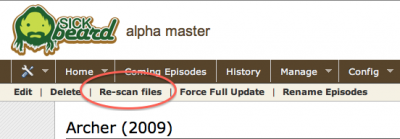
Sick Beard – Re-Scan files to find Specials
NOTE
The Usenet Scene is not always following the correct naming convention for special episodes – this is the reason why Sick Beard cannot always find them!
Sick Beard – Combined Episodes
Sometimes two episodes are aired combined – The TVDB defines them as 2 separate episodes yet only one big episode (both glued together) has been aired. Because of this Sick Beard will not necessarily identify them correctly, for example; it sees only the first one but not the second one. So how do we make it that Sick Beard does recognize them correctly?
Say we have “My Show” and episodes 1 and 2, of season 1, called “Pilot” are aired and saved as 1 file. The naming convention Sick Beard recognizes would be:
“My Show – 01x01x02 – Pilot.avi”
The first “01” is the season, everything following will be considered an episode (so episode 01 and 02 combined).
Once you named your files correctly, do a “Re-Scan” (as illustrated in the previous example) and Sick Beard will identify them correctly.
Downloads keep Piling up
Sick Beard
With the default settings of Sick Beard the downloaded files will not be deleted – a good thing when you’re just starting to play with the Sick Beard and SABnzbd combo. But eventually the “completed” folder of SABnzbd will chew quite a bit of disc space and that’s not really needed when an episode is already copied to another location (the TV Series folder).
The configuration page of Sick Beard helps out in this case.
Go to “Config” → “Post Processing“, uncheck “Keep Original Files” and click “Save Changes“.
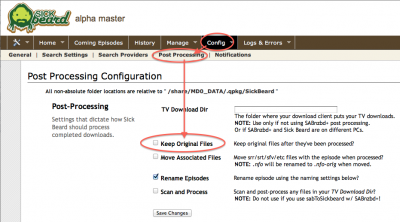
Sick Beard – Remove obsolete downloads
That’s all there is to it (under the assumption that you did setup SABnzbd to use the “sabToSickBeard.py” post processing script (more details in the installation guide).
Couch Potato
Couch Potato files could face the same issue, and as seen with Sick Beard, it’s just a matter of a setting.
Open Couch Potato, click the cog wheel, click the “Renaming” option.
The Renaming option handles the monitoring of your download directory and consequent moving and renaming of the download. It will also create a directory, and add NFO and TBN files for the movie you downloaded.
Check the “Enable” option, and the “Cleanup” option and click “Save” (bottom of the page). As of now Couch Potato will cleanup downloaded files.
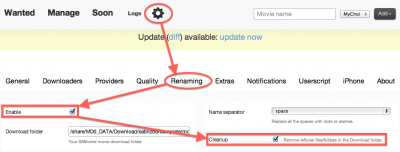
Couch Potato – Cleanup Downloads
Sick Beard / Couch Potato – What are TBN and NFO files?
Sick Beard and Couch Potato might generate some additional (and very useful!) files. For example used by XBMC are the TBN and NFO files. But what are they and how can I view them?
TBN – Thumbnails …
TBN are JPEG formatted thumbnail. To view them simply open them in a (capable) JPEG viewer.
Windows
Copy the following text in a text document for example by using NOTEPAD. Save the file as tbn.reg. After closing Notepad double click the tbn.reg file – Windows will warn you that a registry change is about to happen, confirm this. (source)
1
2
3
|
[HKEY_CLASSES_ROOT\.tbn\ShellEx\{BB2E617C-0920-11d1-9A0B-00C04FC2D6C1}]
@="{3F30C968-480A-4C6C-862D-EFC0897BB84B}"
|
Once you completed that, Windows will treat the TBN file like any other JPEG file.
MacOS X
“Preview” for some reason doesn’t like to show TBN files even when associated. A very fast and helpful alternative is Xee. Download it, install it, it’s free … (make a small donation if you really like Xee).
Right click a TBN file and from the popup menu click the option “Get Info“. A window opens with the information of this file, including but not limited to the definition of what application will be used to open this file – it’s under the “Open width:” section.
Set this to Xee and click the “Change All…” button – as of now, each TBN file will be opened with Xee …
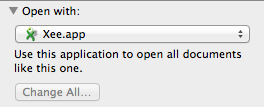
MacOS X – Default open a TBN file with Xee
NFO – Show and Episode Information
The NFO file typically is a text file, and in this particular case a text file with XML formatted data concerning the show or episode. You can read or edit it with pretty much any plain text editor.
For Windows this can be NOTEPAD or my favorite Notepad++ (free).
For MacOS X users I’d like to recommend TextWrangler by Bare Bones Software – it’s free and a very capable text editor, which I highly recommend.
Couch Potato – Stuck in a restart?
Well, it happened to me more than once – Couch Potato got totally stuck in a restart, specially after an update. Even Disabling/Enabling the QPKG didn’t fix the issue. Couch Potato seems frozen/dead (didn’t want to load it’s page). Not sure if this is the best way to do it, but it worked for me.
Step 1 – First DISABLE Couch Potato in the QPKG menu.
Go to the QPKG menu of your QNAP and click Couch Potato. In the upcoming window click “DISABLE“. You can leave this window open – we will need it to ENABLE Couch Potato again.
Step 2 – Open a SSH connection to your QNAP to kill the Couch Potato process.
To be able to access your QNAP through SSH, you will first need to make sure this service is enabled.
Open the QNAP Administration page, on the left under “Home” click “Network Services” → “Telnet / SSH” and make sure “Allow SSH connection” is checked. Click “Apply” if you had to make a change. SSH access is now enabled (you can turn it off again later when done doing these minor changes).
- Windows
Use a SSH program like my personal preference PuTTY (direct download link) or an equally good alternative called WINSCP, and go to the IP address of your QNAP using the username “admin” and the password you defined during setup of your QNAP .
- MacOS X
Simply open a Terminal window (under “Applications” → “Utilities“) and type on the command-line: “ssh admin@<ip of your QNAP>” (without the quotes) and press enter. <ip of your QNAP> should of course be replaced by the IP address of your QNAP, for example: ssh admin@10.0.0.49.
- Linux
- Linux users probably do something similar as MacOS X users; open a shell window and use the SSH command.
Step 3 – Kill the Couch Potato process
Once logged we need to execute the following commands:
This will produce a list of running processes with “Potato” in the name, something like this:
1
2
3
4
| [~] # ps | grep Potato
21368 admin 27176 S /opt/bin/python2.6 CouchPotato.py -q
23293 admin 564 S grep Potato
[~] # |
You see the line with “CouchPotato.py“? That’s your Couch Potato … and we want to kill that task.
The first number (21368 in this example) in that line is the process id (PID) and that’s the number you will need to kill this task.
Execute the following command – WARNING: replace “21368” with the number that you see on YOUR QNAP!!!
Couch Potato is now totally stopped.
Step 4 – Exit SSH and restart Couch Potato
You can now exit the SSH connection (close PuTTY, exit Terminal or shell window) and go to the Couch Potato page that we left open in Step 1 to ENABLE Couch Potato again.
QNAP – Can’t work with files in the SABnzbd Incomplete directory
In very rare situations you might want to “play” with the files downloaded by SABnzbd that are found in the “incomplete” folder. For example when SABnzbd indicates problems in the post-processing (after the download completed – when it wants to extract files).
In maybe 1 out 5 situations I can still recover files from the download, although some files might be damaged, or a file has been password protected and you need to go in manually to extract the file using a password.
The problem you might run into is that you don’t have the proper access rights to the files and/or directory. When using SSH (see previous explanation) you can either use sudo or (and this is what I typically do) chmod (in the directory where the files reside that you want to work with).
The QNAP has tools onboard like unrar to extra files:
This will unrar “filename” including it’s additional rar files.
SABnzb and Sick Beard Browser add-ons
For some browsers, in this example Google Chrome, add-ons or extensions exist for easier access to your Sick Beard or SABnzbd.
I highly recommend exploring SABConnectPlusPlus (Chrome web store) and SickBeardConnect (Chrome web store);
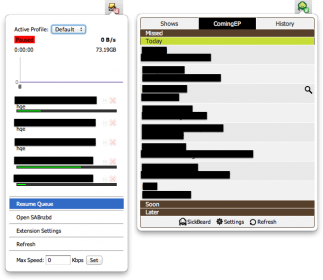
SABconnect++ and SickBeardConnect – highly recommended
Both add-ons show you quickly the status of either SABnzbd or Sick Beard – SABConnectPlusPlus also offers some slick options for visitors fo websites like NBZMatrix, NZBSearch and NZBIndex. When using a service like DynDNS (it has become cumbersome to get a free account here) or No-IP you can even set them up to remotely monitor your download progress.
![]()

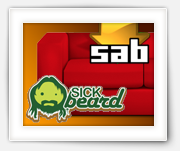






Comments
There are 6 comments. You can read them below.
You can post your own comments by using the form below, or reply to existing comments by using the "Reply" button.
Hey. Great article. Could you show us how to update SABNZBPLUS to version 1.0.0 from 7.x ?
Mr. Johnsen
Thank you for the compliment! Always much appreciated .
.
Ehm … that’s a good question …
I haven’t used SABNzbd in a while (using NZBGet these days).
You can find the latest NZBGet version in the QNAP Forum.
You’ll probably like NZBGet, it’s not only cleaner and more modern looking, but its also faster when downloading.
Of course SABNzbd works just fine too, and you can get the latest version from the QNAP Apps Community.
I’d recommend writing down (or copying or making screenshots) of all your settings, remove the old SABNzbd, and install the one from the apps community.
hans
Thanks. I’ll try to install the latest version, after taking screenshots of every setting.
I’ve tried NZBGET, but i got to many failed downloads with nzbget. So i went back to SABNZBD.
Thanks for helping out.
Mr. Johnsen
That’s interesting, I have had no failed downloads (yet – knock on wood!) with NZBGet. Was this recent?
Does it fail full downloads, or does it fail grabbing nzb files?
Anyhoo … SABNzbd is good too, so if that works, then go with that
hans
Recent…no, it was for about 8 months ago.
It grabs the nzb files, and it start downloading. I agree that the interface look much better than sabnzbd, but it all comes down to whats working and whats not :)
Mr. Johnsen
Makes perfect sense to stick to SABNzbd then!
Happy Easter
hans